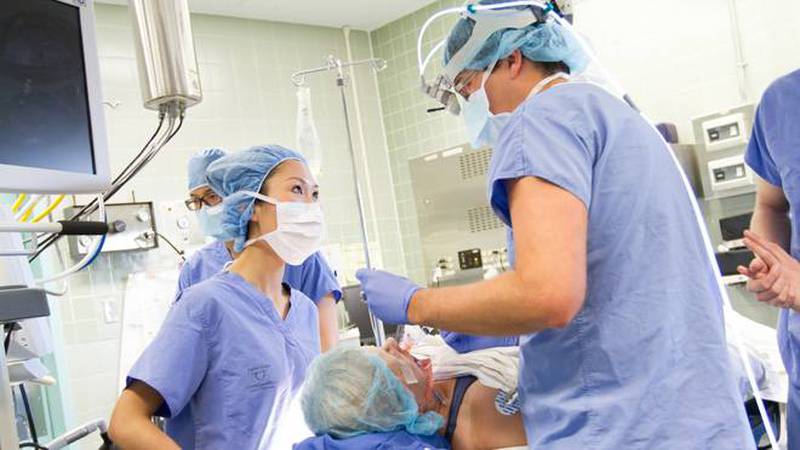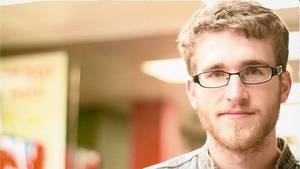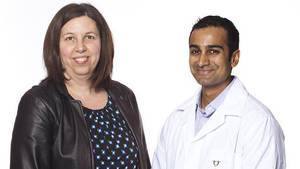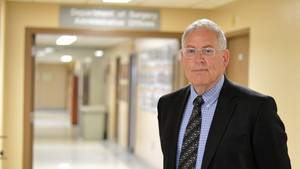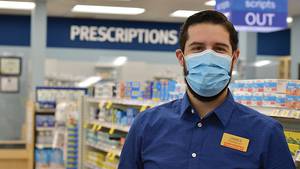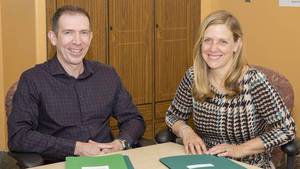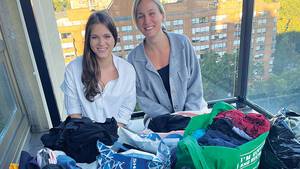Blue scrubs, medical masks and hairnets have all become wardrobe essentials for medical school graduate, Dr. Elaine Fung.
It’s only 7 a.m., and the fourth-year resident is scrubbing-in for the day, explaining her routine at the QEII’s Otolaryngology-Head and Neck Surgery (ENT) unit.
“I’m always a little anxious before going into the operating room for a big case, but I think that’s what makes every day so exciting. I love working on complicated surgeries and there’s such satisfaction in putting everything back together again, and hopefully curing patients of their disease,” says Fung.
The other residents gather around to discuss the day’s fluctuating schedule.
“That’s what is cool about this job. It keeps you on your toes. You will never get bored here,” says 29-year-old Fung. “You never know what’s going to come through the door. Most days you have a set schedule, you go to the clinic or the OR, or see emergency patients. It can be hectic. It can be quiet. Definitely everybody works hard.”
The QEII Health Sciences Centre’s is Atlantic Canada's largest health centre. Its outpatient clinics care for over 646,000 patients a year, and are home to a vast number of research projects. But the QEII offers more than healing and discovery – it also serves as a teaching hospital for tomorrow's health care professionals, including 400 residents from Dalhousie University’s Faculty of Medicine.
Fung came to Nova Scotia in 2009 from Alberta, after completing an undergraduate degree and medical school in Edmonton. Moving to the east coast was a significant step, but one that has rewarded such a risk.
“I love it,” she says of her move. “It’s certainly a big change but I like the people. They’re completely different. It’s a small town feel, but a good-sized city.”
Fung learned about the QEII program through a centralized matching system that pairs applicants with hospitals that meet their criteria. She lives downtown on the peninsula, and enjoys the easy commute to and from the hospital, something she’d be hard-pressed to get in other major Canadian cities.
“Halifax has one of the best programs in Canada,” says Fung of the QEII residency program.
The QEII is Nova Scotia’s only adult teaching hospital, and the largest east of Montreal. The residency program was awarded the best accreditation outcome in Canada in 2012, marking its fifth year receiving top marks.
“It is an excellent choice," says Fung. "Everybody at the hospital is so supportive and the program itself is strong in all the sub-specialties. And because it’s a smaller program, you get to know everyone personally. They are not only your colleagues, but your friends."
Part of her satisfaction with the QEII experience has to do with her mentor, Dr. Mark Taylor. A native of PEI, Taylor did his residency at the University of Western Ontario in London, Ont. After a fellowship in the U.S., he was offered a job at the QEII, where he's been for the past 12 years. He lives in Halifax with his family, including three children aged 15, 14 and eight.
“Dr. Taylor is one of the head and neck oncologists, and that’s the specialty I’d like to go into,” Fung says. “He’s been amazing from the beginning. He’s an excellent surgeon and a patient teacher. He is one of those people with an amazing sense of humour and he truly cares, not only about the patients, but also about the residents and the support staff.”
Dr. Taylor says the admiration is mutual.
“She’s great. She’s a really good resident, really keen and hardworking, and she has a good sense of humour and is fun to be around,” Taylor says. “I think that’s why we get along so well. She’s one of those residents that’s very reliable and always follows through.”
Taylor believes humour is a tool that makes his hectic life a little bit easier.
“I use humour in the operating room and the clinic, and if I’m giving a talk, it makes it more fun,” says Dr. Taylor. “People probably listen and retain more if you give them a few laughs. Everyone wants to be entertained.”
In the operating room, Fung busies herself with preparing the patient while Dr. Taylor continues to keep the mood light, cracking jokes with the residents while supervising the procedure.
“If the mood is lighter and not as serious; I think everyone functions a bit better,” he remarks.
This is a quality Fung hopes she can carry over to her own operating room some day. And given the choice, she would love to eventually call Halifax, and the QEII Health Sciences Centre, home.

